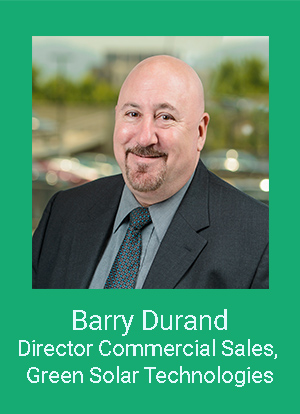 What are the core differences in serving residential and commercial and industrial (C&I) solar markets as a solar contractor? If you’ve ever thought about expanding your residential solar contracting work to serve commercial customers as well, you might find it helpful to understand what these sectors have in common and where they diverge.
What are the core differences in serving residential and commercial and industrial (C&I) solar markets as a solar contractor? If you’ve ever thought about expanding your residential solar contracting work to serve commercial customers as well, you might find it helpful to understand what these sectors have in common and where they diverge.
To get the lowdown on some of the key differences in solar contracting for residential and C&I solar projects, Aurora Solar spoke with Barry Durand, director of commercial sales, and Yashwanth (Yash) Ganti, design engineering manager, at Green Solar Technologies.
Founded in 2010, Green Solar Technologies currently operates in 25 states and Washington, D.C. and has served tens of thousands of solar customers. Green Solar Technologies expanded into commercial solar several years ago, after nearly a decade serving residential solar customers — so Durand and Ganti were well positioned to highlight the important differences between the two sectors.
Our conversation highlighted several notable differences between C&I and residential solar contracting, including differences in the length and complexity of projects, communication with customers, project costs  and financing. Read on to learn more!
and financing. Read on to learn more!
1. C&I solar projects take longer, partially because of permitting complexity.
As Durand explained, “Residential [solar] is a quicker process. As far as determining the size of the system, calculating the [financial] benefits, and actually getting it installed, it typically takes from 4 weeks to 12 weeks.
Commercial, not so much. It’s a lot longer process for people involved with it; it could take anywhere from six months to a year before the project gets done.” A big part of this is the permitting process, which Durand noted “is quite a bit different, and quite a bit longer.”
Ganti reiterated this point, noting that “there’s a lot more review involved from the local jurisdictions.”
“For example, here in the city of Los Angeles, when it’s a residential job under 10 kW, you can apply for permitting approval online and you don’t even have to turn in a plan set. But when it comes to commercial, anything bigger than 10 kW, there is a more detailed review process.”
Ganti explains that after turning in plan sets to the local permitting office, “they’ll give you a time frame to review the entire plan set, which could be up to two weeks. From there, there can be multiple revisions, if they want you to add more detail.”
Durand also noted that these time frame differences affect the sales process. Companies considering expanding their work into C&I solar need to be aware that the commercial solar sales process is longer (a theme that also came up in Aurora’s interview with the Community Purchasing Alliance).
2. Commercial projects are more technical.
Increased technical complexity is another important factor that differentiates commercial solar contracting. As Ganti explains, “From my perspective when it comes to designing a residential and a commercial job, residential is fairly straightforward. It’s on a smaller scale so you’re easily able to identify any technical issues and suggest a cost-effective solution for them right away.”
“But when it comes to commercial, there are much more technical concepts involved. For example, you may be dealing with electrical equipment at a higher rating, such as 2,000 or even 3,000-amp switchgears. You have to understand whether you may need transformer upgrades based on whether the local lines can handle the solar backfeed. Basically, all of the technical considerations get more complex when you transition from residential to commercial.”
Because of this, Durand emphasized that it’s very important for companies considering making this transition to ensure “they have a really good engineering firm or a really good in-house designer that’s very familiar with commercial [projects] to help streamline the process.”
Beyond ensuring technical competence, this can help speed up the permitting process by reducing the need for revisions. Durand explained that an experienced engineering firm or in-house engineer can “make sure that you’ve got [the permit application] done as well as you can the first time. That means a very good site survey and making sure you’ve accurately answered every question.”
“Once you do that, [the permitting process is] going to be a lot more streamlined. Yes, it will still take two to six months to get to the point where the system is ready to be installed — but if you don’t start with that, it could take a year.”
3. Communication with customers differs from residential solar projects.
Communication with customers is also somewhat different for C&I solar contracting compared to residential. Because commercial projects span over a much longer time, it’s important to establish clear expectations at the outset for the length of time the project will take.
“The difference is all about length of time,” says Durand. “With a homeowner, the minute you sign an agreement with them, they want solar on [their house] tomorrow… You have to communicate with them every few days… it’s a totally different animal.”
“With commercial, we manage those expectations a certain way,” letting them know “it’s going to take six months to a year.” Because of that, the frequency of communication may be less than with a homeowner (though of course clarity in communication and regular updates are important in all solar projects).
4. Commercial projects have higher costs, but lower costs per watt.
Another key difference between residential and commercial solar projects is in the costs. While it’s intuitive that the price tag of a large C&I project will be greater than for a small residential solar system, Ganti and Durand highlighted some particular aspects of C&I projects that come with much higher costs.
“For example,” Ganti noted, “if you have to upgrade an electrical panel, it will probably cost you about $2,000 in a residential job. When it comes to commercial, you’re actually looking at upgrading the local transformer, which could cost from $4,000 to $20,000 or more depending on the local transformer and other technical factors.”
Despite this, because of the economies of scale at play in commercial projects, the cost per watt of commercial projects tends to be lower. “A contractor can end up saving money on a cost per watt basis for a [commercial] installation due to the fact that some of these costs are set, whether residential or commercial.” He cited the cost of truck rolls to bring staff to a project site as an example. Additional savings come from buying hardware components in bulk.
For these reasons, for contractors that are prepared to manage the complexity of C&I solar projects, it can be a very lucrative sector.
5. Financing for commercial solar projects is less accessible.
A final important difference between residential and C&I solar relates to financing. Durand notes that “it’s a lot easier access to finance for the residential market than for commercial,” a factor that has held back the growth of the C&I sector.
Durand notes that in residential solar, financing options have been more developed, whereas the C&I sector is somewhat new territory. Despite that, he observes “there are more and more ways to start financing your commercial projects; not everybody wants to pay cash.” He recommends that for businesses that have a relationship with their own bank, that can be a great place to start when seeking a solar loan.
Although commercial and residential solar contracting diverge in a number of respects, a final takeaway from our conversation with Durand and Ganti was that, ultimately, the two sectors are not so different. “As long as [contractors]… hire the right engineering firm, have the right equipment, and the skills to do the installation, it’s the same process,” says Durand. “[Commercial solar is] not that difficult, it’s just a matter of having all of your ducks in a row when you start.”








Tell Us What You Think!